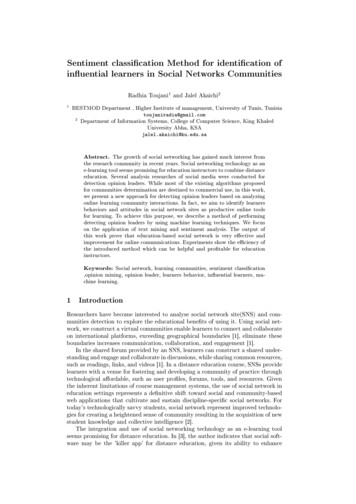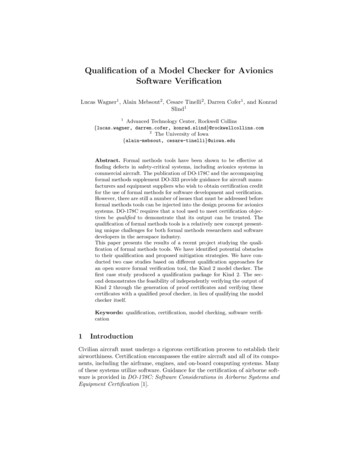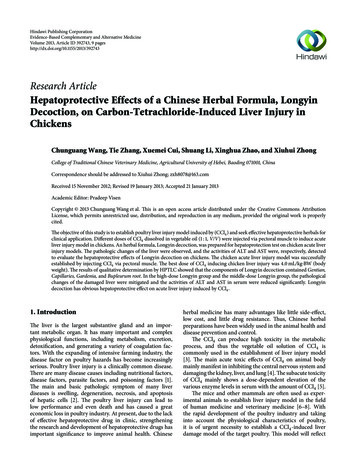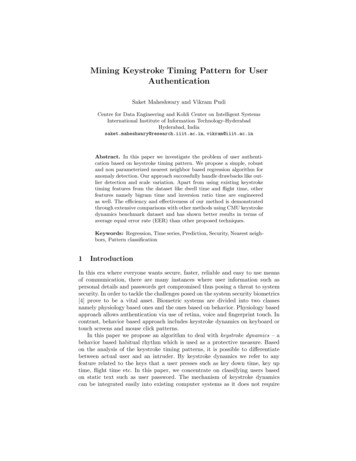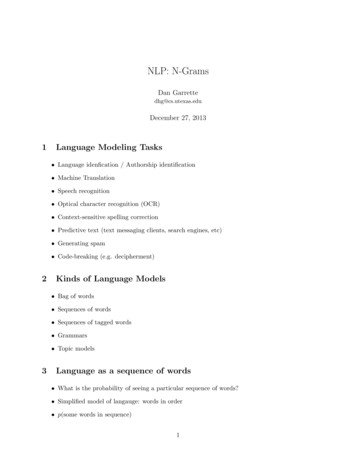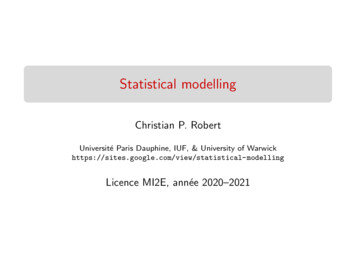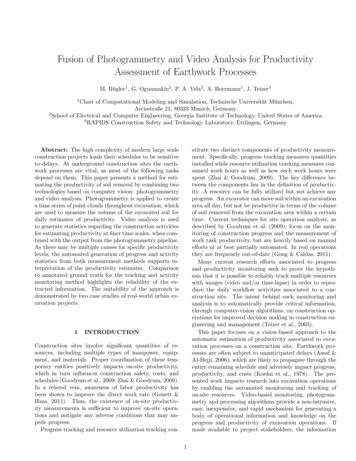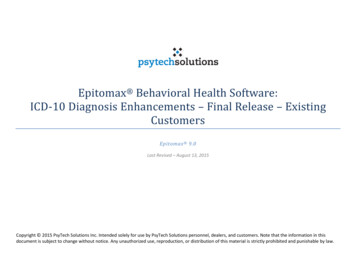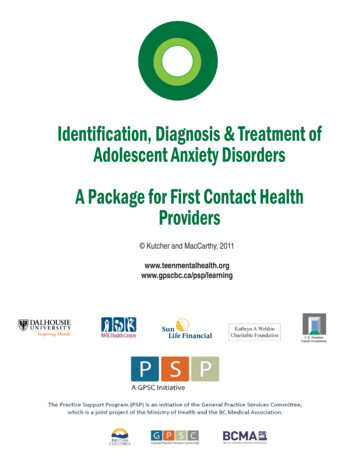
Transcription
Identification, Diagnosis & Treatment ofAdolescent Anxiety DisordersA Package for First Contact HealthProviders Kutcher and MacCarthy, ning
Identification, Diagnosis & Treatment of Adolescent Anxiety DisordersA Package for First Contact Health ProvidersCreated by:Alexa Bagnell, MD, FRCPC, Assistant Professor in Psychiatry, Child and Adolescent PsychiatristTreatment of Anxiety Program, Dalhousie University (Halifax, NS)Stan Kutcher, MD, FRCPC, Sun Life Financial Chair in Adolescent Mental Health & Director, WHOCollaborating Center, Dalhousie University, (Halifax, NS)Iliana Garcia‐Ortega, MD, Psychiatrist Research Associate, Sun Life Financial Chair in AdolescentMental Health, Dalhousie University & IWK Health Centre (Halifax, NS)External Observers:Practice Support Program Child and Youth Mental Health Module Content CommitteeAndy Basi, EdD, MBA, CHE, ART, Executive Lead, Practice Support Program (Vancouver, BC)Charles Blackwood, MDChristina Southey, MSc, Quality Improvement Advisor, Impact BC (Vancouver, BC)Garey Mazowita, MD, FCFP, Clinical Professor, Department of Family Medicine, Universityof British Columbia, Head, Department of Family and Community Medicine, ProvidenceHealth CareGayle Read, Senior Mental Health Consultant, Ministry of Children and Family Development(Victoria, BC)Jane Garland, MD, FRCPC, Clinical Professor, Department of Psychiatry, University of BritishColumbia, Clinical Head, Mood and Anxiety Disorders Clinic, British Columbia's Children'sHospital, (Vancouver, BC)Jessica K. Bruhn, BA, BC Provincial Family Council Co‐chair, Institute of Families for Child &Youth Mental Health (Vancouver, BC)Judy Huska, RN, BScN, Executive Director Quality Improvement, Impact BC ( Vancouver BC)Kimberly McEwan, Phd, RPsych.Liza Kallstrom, MSc, Content and Implementation Lead, Practice Support Program(Vancouver, BC)Olga O’Toole, Child and Youth Mental Health Manager, Ministry of Children and FamilyDevelopment (Vancouver, BC)Olivia Sampson, MD (Vancouver, BC)Robert Lampard, Ph.D., R. Psych, Ministry of Children and Family Development, Child &Youth Mental Health (Victoria, BC)Sherry Bar, Research Officer, Primary Health Care, Ministry of Health (Victoria, BC)Wilma Arruda, BSc, BEd, MD, FRCPC, Consulting Paediatrician, Co Medical Director, Child,Youth and Family Health, Vancouver Island Health Authority (Nanaimo, BC)1Identification, Diagnosis & Treatment of Adolescent Anxiety DisordersA Package for First Contact Health Providers ‐ Kutcher and MacCarthy, 2011
Rivian Weinerman, MD, FRCPC, Regional Head, Division of Collaborative Care, Departmentof Psychiatry, Vancouver Island Health Authority (Victoria, BC)Sandy Wiens, Ministry of Child and Family Development (Victoria, BC)Acknowledgement: Pamela Hinada provided technical assistance and project coordination. This material is under copyright.This material cannot be altered, modified or sold.Teens and parents are welcome to use this material for their own purposes. Health providers are welcome to usethis material in their provision of health care. Educators are welcome to use this material for teaching or similarpurposes. Permission for use in whole or part for any other purpose must be obtained in writing from either Dr.Stan Kutcher at skutcher@dal.ca or from Dr. Dan MacCarthy (dmaccarthy@bcma.bc.ca) at the British ColumbiaMedical Association (BCMA).2Identification, Diagnosis & Treatment of Adolescent Anxiety DisordersA Package for First Contact Health Providers ‐ Kutcher and MacCarthy, 2011
IntroductionThis package is provided as an overview of anxiety disorders in adolescents and how firstcontact health providers can identify and address this issue in an effective, clinically relevantand best evidence‐driven manner.The package is divided into two parts:1) OverviewAn informational overview to help first contact health providers understand how toidentify, diagnose and treat anxiety disorders in adolescents.2) ToolkitA toolkit for first contact health providers containing useful resources for assessing andtreating anxiety disorders in adolescentsThroughout this package hyperlinked text is highlighted in blue underline that, when clicked,will link to either a resource within the package or to an external website where additionalinformation can be found.This program offers the health care provider a comprehensive, sequential and rationalframework for addressing adolescent anxiety. Each health care provider will be able toextract from this program those components that they can best apply in their own practicesetting. By building on the information presented in this course and by utilizing thosecomponents of the toolkit that best meet the realities of their practice each health careprovider can customize their approach to the treatment of the young person with anxiety.For health care practices in which there exist family care teams, providers can use the variouscomponents of the toolkit, with the team leader being responsible to ensure integratedmonitoring of ongoing care.Primary health care providers can appropriately deliver effectivetreatment for anxiety disorders to children. Here’s how Key steps1. Identification of youth at risk for anxiety disorders2. Useful methods for screening and diagnosis of anxiety disorders in theclinical setting3. Treatment template4. Suicide assessment5. Safety and contingency planning6. Referral flags3Identification, Diagnosis & Treatment of Adolescent Anxiety DisordersA Package for First Contact Health Providers ‐ Kutcher and MacCarthy, 2011
Step 1. Identification of children at risk for anxiety disordersChild and Adolescent Mental Health Screening QuestionsHistorical factors:1.Parent has a history of a mental disorder (including substance abuse/dependence)2.Family has a history of suicide3.Youth has a childhood diagnosis of a mental disorder, learning difficulty, developmentaldisability, behavioural disturbance or school failure4.There has been a marked change in usual emotions, behaviour, cognition or functioning(based on either youth or parent report)One or more of the above answered as YES, puts child or youth into a high risk group. The moreYES answers, the higher the risk.Current situation:1.Over the past few weeks have you been having difficulties with your feelings, such as feelingsad, blah or down most of the time?2.Over the past few weeks have you been feeling anxious, worried, very upset or are youhaving panic attacks?3.Overall, do you have problems concentrating, keeping your mind on things or do you forgetthings easily (to the point of others noticing and commenting)?If the answer to question 1 is YES – for adolescents, consider a depressive disorder andapply the KADS evaluation and proceed to the Identification, Diagnosis and Treatmentof Adolescent Depression.If the answer to question 2 is YES – consider an anxiety disorder, apply the SCAREDevaluation and proceed to the Identification, Diagnosis and Treatment of Child or YouthAnxiety DisordersIf the answer to question 3 is YES – consider ADHD, apply the SNAP evaluation andproceed to the Identification, Diagnosis and Treatment of Child or Youth ADHD.Remember that some cases of anxiety and depression may demonstrate positive scoreson the concentration component of the SNAP. If no hyperactivity components areidentified on the SNAP review for ADHD please assess for depression and anxiety usingKADS and SCARED.Next steps: If patient is positive for depression and either Anxiety or ADHD and the patient isan adolescent, continue to apply the KADS protocol for Depression.4Identification, Diagnosis & Treatment of Adolescent Anxiety DisordersA Package for First Contact Health Providers ‐ Kutcher and MacCarthy, 2011
If positive for Depression, treat the depression and following remission reviewfor presence of continued Anxiety Disorder or ADHD.If positive for Anxiety Disorder at that time, refer to specialty mental healthservices for specific anxiety disorder psychotherapy (CBT) and continue SSRImedication treatment.If positive for ADHD at that time, add a psychostimulant medication followingthe protocol in the ADHD module or refer to specialty mental health services.Fast Facts about Adolescent Anxiety Adolescence comprises the years from puberty to the mid‐twentiesAnxiety disorders affect 8‐10% of adolescentsMost anxiety disorders begin in childhood and adolescent years.Anxiety disorders are hereditaryMany individuals with anxiety disorders experience physical symptoms and present totheir family physician or health care provider.An individual can be affected by different anxiety disorders throughout their lifespan.Separation anxiety disorder is a common childhood anxiety disorder and can be aprecursor for other anxiety disorders in adolescents and young adults.Onset of anxiety can lead to poor economic/vocational/interpersonal outcomes andincreased morbidity (comorbid anxiety disorders, major depressive disorder, and alcoholand drug abuse) and mortality (suicide).Chronic anxiety can lead to poorer health outcomes and increased cardiovascularmorbidity and mortality.Effective treatments that can be provided by first contact health providers are availableEarly identification and early effective treatment can decrease short‐term morbidity andimprove long‐term outcomes (including decreased mortality)Identification of Youth at Risk for Anxiety DisorderFirst contact health providers are in an ideal position to identify youth who are at risk todevelop an anxiety disorder. The following table has been compiled from the scientificliterature and is presented in a format that can be efficiently used by a health provider toidentify those young people who should be periodically monitored for onset of anxiety.5Identification, Diagnosis & Treatment of Adolescent Anxiety DisordersA Package for First Contact Health Providers ‐ Kutcher and MacCarthy, 2011
Anxiety Disorder in Youth, Risk Identification TableSignificant risk effect1.Family history of anxietydisorder2.Childhood onset anxietydisorder3. Severe and/or persistentenvironmental stressors inchildhood.Moderate risk effectPossible “group” identifiers(these are not causal for anxietydisorder but may identify factorsrelated to adolescent onsetanxiety)1. Children with shy, inhibitedand/or cautioustemperament (innatepersonality type).1.School failure or learningdifficulties2.Socially or culturally isolated2. Family history of a mentalillness (mood disorder,substance abuse disorder)3.Bullying (victim and/orperpetrator)3. Experiencing a traumaticEvent4. Gay, lesbian, bisexual,transsexual4. Substance misuse and abuse(early onset of use includingcigarette and alcohol)What to do if a youth is identified as at risk?Educate about riskAn anxiety disorder is not inevitable but it may occur. If it occurs, the sooner it is diagnosed andeffectively treated, the better. It is better to check out the possibility that problems may beanxiety related than to ignore symptoms if they occur. Primary care health professionals whoprovide services to families are well placed to educate parents about potential risks for anxietyin their children. Family members (youth included) should be made aware of their familial riskfor mental disorders the same way they are made aware of their family risk for other disorders(eg: heart disease, breast cancer, etc.). It is useful to discuss the issue of confidentiality, whatwill and what will not be shared with parents if the young person develops an anxiety disorder.This may make early interventions easier. A good time to have this discussion with the youthand parents is during early adolescence. A note describing the discussion and its outcomeshould be made in the patient record. Access additional resources for parents about adolescentanxiety.Obtain and record a family history of mental disorderPrimary health care providers should take and record a family history of mental disorders(including substance abuse) and their treatment (type, outcome) as part of their routine historyfor all patients. This will help identify young people at risk on the basis of family history.Agree on a “clinical review” threshold6Identification, Diagnosis & Treatment of Adolescent Anxiety DisordersA Package for First Contact Health Providers ‐ Kutcher and MacCarthy, 2011
If the young person is feeling very anxious, distressed, sad and/or irritable, and they are notfunctioning as well (avoidance, poor coping) at home, school or socially, for more than severalweeks, this should trigger an urgent clinical review. The onset of suicidal ideation, a suicide planor acts of self‐harm must trigger an emergency clinical review.Arrange for a standing “mental health check‐up”The mental health check‐up could be 15‐minute office/clinical visits every 3 to 6 months duringthe teen years in which a clinical screening for anxiety is applied. The Screen for Child AnxietyRelated Emotional Disorders (SCARED) is a 41‐item anxiety screen with a child and youth selfreport as well as a parent report found at the links provided in the section below.A recommended clinician monitoring tool for Social Phobia (the most common anxiety disorderin adolescents) is the Kutcher Generalized Social Anxiety Disorder Scale for Adolescents (K‐GSADS‐A) which is also found in the next section below.One potentially useful approach is to ask the young person or parent to bring in the youth’sschool reports. Check for a pattern of declining grades, frequent lates or frequent absences.Although not specific for an anxiety disorder, these patterns may indicate a mental healthproblem.Confidentiality and understanding that treatment is by informed consentPart of the education about risk should include a discussion about confidentiality and informedconsent to treatment for both the young person and the parents. This information may make iteasier for the young person to access care if they become anxious as they may be morecomfortable in sharing their distress. For parents, knowing what they can expect in terms ofbeing informed about their child may help them feel more comfortable about how treatmentwill occur if it becomes necessary.Step 2. Useful methods for screening and diagnosis of anxietydisorders in the clinical settingAn overall mental health screening should be part of general health visits. As youth generallyvisit health care providers infrequently, screening should be applied to both high risk and usualrisk youth at scheduled clinical contacts. Teen visits for contraception or sexual health issuesprovide an excellent opportunity to screen for mental health problems and mental disorders.Young people with severe anxiety may be embarrassed to spontaneously report what they arefeeling. They frequently complain of vague physical symptoms. Gentle questioning aboutanxiety may be needed to assist them with raising the issue with their health provider.An anxiety disorders self‐test with good sensitivity and specificity (such as the SCARED) shouldbe used. When appropriate, it is helpful to have a parent report as well, particularly in youngerteens. The SCARED has both a SCARED child self report and a SCARED parent report and can beused by clinicians at no cost. This instrument has been studied in clinical and populationsamples and demonstrated excellent sensitivity and specificity. Ensure that you provide theyoung person with feedback on their result.7Identification, Diagnosis & Treatment of Adolescent Anxiety DisordersA Package for First Contact Health Providers ‐ Kutcher and MacCarthy, 2011
It is helpful to screen highly anxious teens for depression and suicide as well. TheKutcher Adolescent Depression Screen (KADS) is a 6 item screen for depression andthe Tool for Assessment of Suicide Risk (TASR) is a useful template for assessingsuicide risk.The 18‐item Kutcher Generalized Social Anxiety Disorder Scale for Adolescents (K‐GSADS‐A)can be filled out by the clinician with the young person and is available in a number of differentlanguages and is helpful for monitoring treatment response in social anxiety disorder. Teenswith anxiety disorders have higher risk of depression.The 6 item KADS (Kutcher Adolescent Depression Scale) and 18 item K‐GSADS‐A (KutcherGeneralized Social Anxiety Disorder Scale for Adolescents) may be used by clinicians.Clinicians who wish to use the KADS or K‐GSADS‐A in their work are free to apply it usingthe directions accompanying the scale. Clinicians who would like training on the KADS, K‐GSADS‐A, and the tool for assessing teen suicide risk (TASR) are encouraged to contact theoffice of the Sun Life Financial Chair in Adolescent Mental Health at (902) 470‐6598.8Identification, Diagnosis & Treatment of Adolescent Anxiety DisordersA Package for First Contact Health Providers ‐ Kutcher and MacCarthy, 2011
Diagnosis of Anxiety Disorders in AdolescenceAnxiety for some young people may only occur in very specific situations or environments andfor others can be more generalized. It is important to distinguish between appropriate andadaptive anxiety and stress (usefully called distress), and an Anxiety Disorder. An AnxietyDisorder is of long duration (usually lasting for many months), significantly interfering withfunctioning, and often out of synch with the magnitude of the stressor. Anxiety Disorders willusually require health provider intervention, while stress is usually of short duration (less than acouple of weeks) and is likely to resolve spontaneously or be substantially ameliorated by socialsupport or environmental modification alone.Diagnosis of Anxiety Disorders in adolescents is currently made using DSM IV‐TR criteria.Distress Usually associated with an event or seriesof events Functional impairment is usually mild Transient – will usually ameliorate withchange in environment or removal ofstressorProfessional intervention not usuallynecessary Can be a positive factor in life – personlearns new ways to deal with adversityand stress management Social supports such as usual friendshipand family networks help Counseling and other psychologicalinterventions can help Disorder May be associated with a precipitating event,may onset spontaneously, often some anxietysymptoms predating onset of disorder Functional impairment may range from mild tosevere Long lasting or may be chronic, environment maymodify but not ameliorate External validation (syndromal diagnosis:DSM*/ICD*) Professional intervention is usually necessary May increase adversity due to resulting negativelife events (e.g.: anxiety can lead to schoolrefusal and avoidance of normal developmentalsteps like independent activities with peers) May lead to long term negative outcomes (socialisolation, low self esteem, lack of independence,depression, substance abuse, etc.) Social supports and specific psychologicalinterventions (counselling, psychotherapy) areoften helpful Medications may be needed but must be usedproperlyMedications should not usually be used* DSM‐ Diagnostic and Statistical Manual* ICD – International Classification of Diseases9Identification, Diagnosis & Treatment of Adolescent Anxiety DisordersA Package for First Contact Health Providers ‐ Kutcher and MacCarthy, 2011
Clinical Screening for Child Anxiety in the Primary Care SettingClinical screening can be effectively and efficiently conducted by primary care providers – whoare often the first point of contact for concerned parents or school authorities and who mayknow the young person and family well. Conducting this brief screening question may allow thehealth provider to recognize if further anxiety investigation is needed or not.Who to screen? Teen presenting with symptoms of nervousness, frequent and excessive worries andfears, difficulties concentrating, behavioral problems, academic underachievement orsleep problems. Teen with numerous physical complaints about being tired, frequent headaches orstomach aches, nausea and light headedness which are not easily explained by a knownphysical illness and which vary in duration, frequency and intensity over a long period oftime. Teen at risk. See the Anxiety Disorder in Youth, Risk Identification Table.Refer to Child and Adolescent Mental Health Screen Questions. These questions can beincluded in clinic/office registration materials to be completed by parents or patients beforevisits, or in the waiting room before the evaluation screening.Screening Questions for Anxiety and OCD in Primary Care Setting Do you worry more than other teens you know?What do you worry about?Does worry/anxiety ever stop you from doing something that you would like to be able todo?Are there any events/activities/people/places that you avoid because of fear or anxiety?Describe your sleep routine (where, when, quality, night routine)?Have you ever missed school or had to come home from school early due to anxiety?Have you ever had anxiety where your heart raced, you couldn’t catch your breath, you feltdizzy or lightheaded and thought you might be dying?Do you get a lot of stomach aches and headaches?Do you have trouble concentrating?Do you have ideas or images that come into your mind and you can’t control them?Do you have any routines or behaviours you need to do to relieve anxiety or distressfulthoughts or images? (e.g. ask about germs/dirt worries and handwashing/cleaning, alsocounting and checking rituals)What would be different for you if you didn’t have anxiety/worry?Diagnosis of Anxiety Disorder in Adolescence using the SCAREDThe SCARED is a self‐report instrument that can be helpful in the diagnosis and monitoring ofanxiety disorders in young people. Information on scoring of the SCARED is found on theinstrument itself.10Identification, Diagnosis & Treatment of Adolescent Anxiety DisordersA Package for First Contact Health Providers ‐ Kutcher and MacCarthy, 2011
An anxiety disorder in an adolescent should be suspected if a SCARED score of 25 or higher isfound at screening.A high SCARED score (25 or higher) does not mean that a patient has a clinical anxietydisorder; it simply suggests a possible diagnosis and the score/items can be used as a guidefor further questioning.If a SCARED score of 25 or higher is found during screening the following is suggested: Discussion about important issues/problems in the youth’s life/environment.Complete or use the Teen Functional Activities Assessment (TeFA) to assist indetermining the impact of the depression on the teens functioning. Supportive, non‐judgmental problem solving assistance – “supportive rapport” (usethe Psychotherapeutic Support for Teens (PST) as a guide to this intervention) –strongly encourage and prescribe: exercise; regulated sleep; regulated eating;positive social activities Screen for depression‐ use the Kutcher Adolescent Depression Screen (KADS) Screen for suicide risk ‐ use the Tool for Assessment of Suicide Risk (TASR) Mental health check‐up about 1 week from visit. This visit could also include theTeFA and/or PST so schedule about 15‐20 minutes. If concerns about depression orsuicide then KADS and TASR should be utilized. A third visit 2 weeks later to check in, repeat SCARED and other appropriate screens,and make treatment plan as indicated.Don’t get overwhelmed!Yes, there are a number of clinical tools and they address important issues in diagnosis andtreatment of adolescent anxiety disorders. However a full assessment of anxiety can becompleted in three 15‐minute office visits using the suggested framework above. Someclinicians may prefer to integrate the details found in the tools into their assessment interviewsrather than using the tools separately. If there is concern about depression and/or suicide risk,then these screening tools should be used at each visit.11Identification, Diagnosis & Treatment of Adolescent Anxiety DisordersA Package for First Contact Health Providers ‐ Kutcher and MacCarthy, 2011
Types of Anxiety DisordersAnxiety Disorders are the most common psychiatric illnesses in children, adolescents andadults. Anxiety is a physiological response that is essential to human beings and survival,involving “fright/flight” neurobiology. In anxiety disorders, this response is no longer adaptiveand is either out of proportion to a stressor, or occurs when there is no threat. Due to thephysiological mechanisms activated with the anxiety and stress response in the body,individuals with chronic anxiety and stress have more risk of both physical and mental healthproblems. Individuals with anxiety often present to their primary health care provider withfrequent physical complaints, and not necessarily reporting anxiety. There are many types ofanxiety disorders, and prevalence varies depending on age group. Four of the most commonanxiety disorders with onset in adolescence are social anxiety disorder, generalized anxietydisorder, panic disorder and obsessive compulsive disorder.Social Anxiety Disorder (Social Anxiety Disorder DSM‐IV‐TR diagnostic criteria)Social Anxiety Disorder (Social Phobia) is the most common anxiety disorder in adolescents.Often these youth are identified as “shy” or “introverts”, which is not accurate. Youth whosuffer from social anxiety disorder have severe anxiety in social situations that is verydistressing and can lead to avoidance and significant deterioration in overall function. Youthwith social anxiety disorder describe an overwhelming fear of drawing attention to themselvesor saying something stupid or embarrassing around others, especially peers. This can lead tonot being able to ask questions in class, not able to talk in front of others, avoidance of usingphone, not ordering in restaurants, and not using public bathrooms. When social anxietydisorder is quite severe it can result in isolation to the point where the individual rarely leavestheir home, does not have contact with friends and stops attending school. Social anxietydisorder has significant developmental and functional impact on youth at a time when theyshould be developing their own identity and independence. Without treatment these youth candevelop depression, have higher risk of substance abuse and higher rates of not completingschool.Generalized Anxiety Disorder (Generalized Anxiety Disorder DSM‐IV‐TR diagnostic criteria)Generalized Anxiety Disorder (GAD) can have onset in childhood and adolescent years. Youthwith GAD can be described as “master worriers”. Their anxiety is around everyday events andresponsibilities in their life, but their distress and worry is excessive, unrealistic and/orunhelpful, and persists for at least 6 months. GAD sufferers have significant distress bothmentally and physically due to their anxiety. Youth may report feeling tense, irritable, frequentmuscle aches and pains, and difficulty concentrating due to the intensity and chronicity of theworried thoughts and feelings. These symptoms can make it difficult to fall asleep, or to getrestful sleep, and this increases distress. Individuals with GAD may have academic performanceanxiety that interferes with starting and completing assignments and taking tests, due to fear offailure or that it will not be “good enough”. A pattern of avoidance can develop to prevent“failure” or “something bad happening”, and the youth may seek excessive reassurance fromothers that “everything will work out or be okay”. These anxious behaviours lead to increased12Identification, Diagnosis & Treatment of Adolescent Anxiety DisordersA Package for First Contact Health Providers ‐ Kutcher and MacCarthy, 2011
anxiety and interfere with overall function, and lead to lack of enjoyment and avoidance ofeveryday activities.Panic Disorder (Panic Disorder DSM‐IV‐TR diagnostic criteria)Panic disorder has onset in adolescent years, and although not the most common anxietydisorder, can become very debilitating quite rapidly. Panic attacks (Panic Attacks DSM‐IV‐TRdiagnostic criteria) most commonly first present to an emergency room or urgent care becausethe physical symptoms are acute and escalate quickly similar to having a heart attack, asthmaattack or even stroke or seizure. The individual becomes extremely afraid and believes they aredying or that something terrible is going to happen. Panic attacks can occur in any anxietydisorder or high distress situation. However, in panic disorder these attacks occur “out of theblue” without clear precipitants or warning. This causes extreme fear and anxiety of havinganother attack, particularly in a place where others might see them or where escape or helpmight not be possible. Individuals with panic disorder will avoid any situation they associatewith feeling panicky, or places where they fear that if they did have an attack they would not beable to manage or get help. In many individuals this can lead to staying closer to home to thepoint where you will not go to places where there may be groups of people or crowds(agoraphobia). In teens with panic disorder, they may stop all extra curricular activities, refuseto go anywhere without their parent, and may stop going to school (or have extreme distresswith school attendance). This deterioration can happen quite rapidly for some individuals evenafter only one or two panic attacks. Individuals with panic disorder can develop depressivesymptoms quite rapidly and have a higher associated risk of suicide than other anxietydisorders.Obsessive Compulsive Disorder (Obsessive Compulsive Disorder DSM‐IV‐TR diagnosticcriteria)Obsessive Compulsive Disorder (OCD) is an anxiety disorder involving obsessions (distressingintrusive thoughts and/or images) and/or compulsions (repetitive behaviours or ritualsperformed to relieve distress and anxiety associated with the obsessions) that are unwanted,cause significant anxiety, and interfere with functioning (taking up more than one hour perday). The most common obsession themes are illness and danger related, and the mostcommon compulsions are cleaning
Anxiety disorders affect 8‐10% of adolescents Most anxiety disorders begin in childhood and adolescent years. Anxiety disorders are hereditary Many individuals with anxiety disorders experience physical symptoms and present to their family physician or health care provider.
